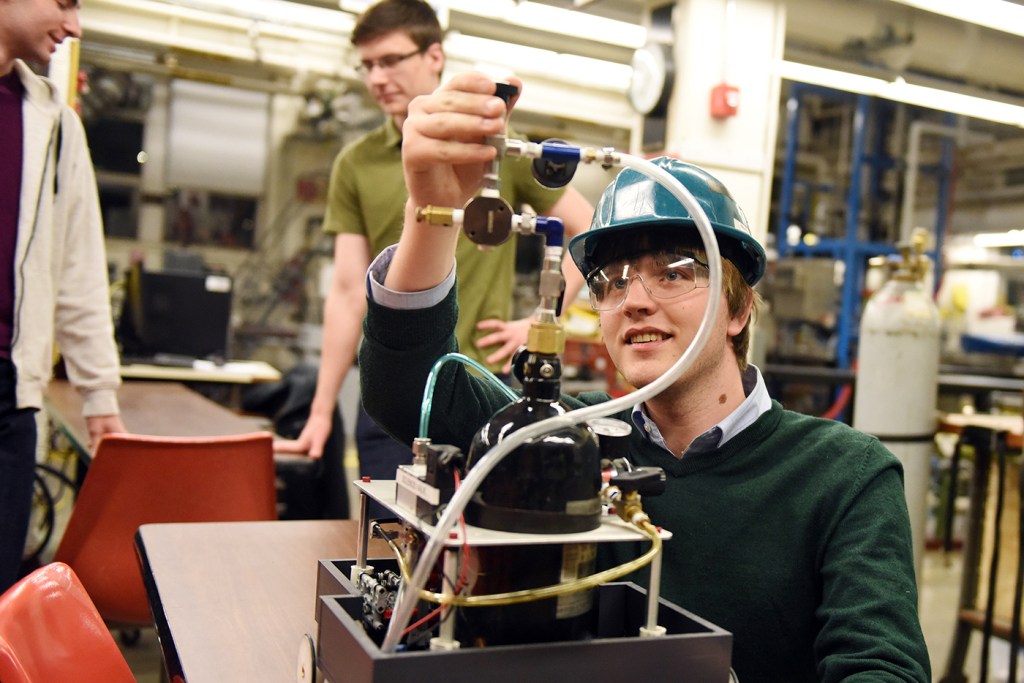How will Northeastern’s chem-e-car ‘react’ in regional competition?

Last Saturday, a small, mechanical car was zipping up and down the Unit Operations Lab, a state-of-the-art facility in the Mugar Life Sciences Building. It was Chemical Engineering Day at Northeastern and a few students on the university’s chem-e-car team were showing a group of alumni how it worked.
“I think we’re on track to do really well this spring,” said team co-captain Cory Sweezo, E’18, referring to the group’s upcoming performance in the American Institute of Chemical Engineers’ 2016 Northeast regional chem-e-car competition in April. “We’re never ready this early.”
The team has had a long history of success, to be sure, winning the national competition in 2009 and thrice placing first in the regional competition over the past seven years. But it has never worked with such alacrity, such focus.
Come April, said Sweezo, the team will have spent more than 1,000 man-hours designing and fabricating the car. The machine itself, nickname forthcoming, stands 18 inches tall and weighs approximately 25 pounds. It’s made of aluminum and powered by an iodine clock reaction triggered by a combination of potassium iodine, sulfuric acid, starch, sodium, thiosulfate, and hydrogen peroxide.
“I think the team’s success comes from our desire to innovate,” said co-captain Justin Ramberger, E’18. “Each year, we try to come up with new ideas that have never been tried in competition before.”

Students work on chemical reaction equations for the chem-e-car.
At the regional competition this spring, 12 teams will be judged on a poster presentation as well as their car’s ability to travel a specified distance and then stop. The distance the car must travel, between 30 and 100 feet, will be announced one hour before the competition, making it particularly important for each team to know the ins and outs of its chemical reaction.
“We want to make sure we know how different compositions of chemicals will affect the distance the car will travel,” Sweezo explained. “In order to find out, we have to do a lot of testing.”
I think the team’s success comes from our desire to innovate.”
— Justin Ramberger, E’18, co-captain of the chem-e-car team
Both he and Ramberger noted that their co-op experiences have informed the design of the car and improved their leadership acumen.
As an engineering co-op at W.L. Gore and Associates, the Delaware-based manufacturing company, Ramberger learned how to design safe, effective experiments. As he put it, “that’s a key skill for any scientist or engineer.”
Sweezo’s current co-op at the Rogers Innovation Center, which is based at Northeastern’s George J. Kostas Research Institute for Homeland Security, has piqued his interest in materials engineering, making him the team’s point person for all things chem-e-car. “Before this co-op, I worked solely on the chemicals team,” he explained. “Now, I’m more knowledgeable about the structural qualities of materials and how they work.”
Courtney Pfluger, the team’s faculty advisor, believes that the group’s tireless dedication to designing a quality car will pay off in the regional competition. “The car ran really well last weekend,” said Pfluger, assistant teaching professor in the first-year engineering program. “We’re going to keep on testing it and making sure the reactions are faring the way we want them to.”





